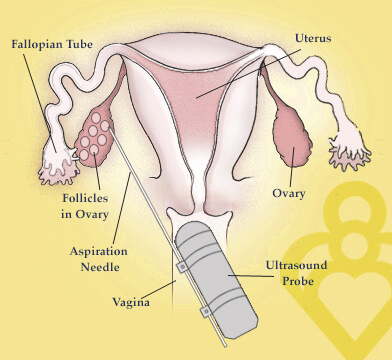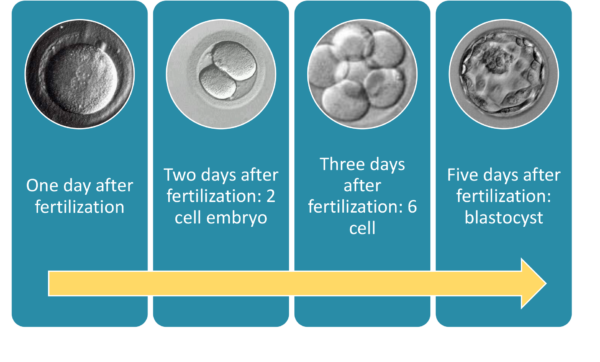You and your partner should have a clear understanding of the steps in the IVF process
IVF can be physically and emotionally draining, however stress and anxiety can be reduced if you and your partner have a clear understanding of the IVF process steps. Your doctor may recommend that you and your partner learn as much as possible about the IVF process steps, which includes the following:

IVF Process Step 1 – Stimulation of Ovaries
To begin, the woman will be given medications to stimulate her ovaries to form multiple eggs. Your doctor will monitor this process with blood tests and ultrasound. Your doctor will also discuss with you which medication protocol might work best. Usually, you will receive a drug known as a gonadotropin-releasing hormone agonist (an example is Lupron®) or a gonadotropin-releasing hormone antagonist (examples are Antagon® and Cetrotide®). These drugs prevent your ovaries from releasing eggs too early during your IVF cycle.
These medications are given daily as an injection in your abdomen, thigh or upper arm. Your doctor will determine the most appropriate dose for you and will inform you of the possible risks, side effects and benefits of these medications.
IVF Process Step 2 – Egg Retrieval

Egg retrieval is the next step in the IVF process steps and is a surgical procedure performed in an operating room. An anesthesiologist will be present during the procedure and may give you an intravenous sedation to make you sleepy.
During the egg retrieval procedure, your doctor will place a needle along with an ultrasound probe into your vagina. The needle will be gently moved through the back of your vagina into each mature follicle in your ovaries. Since the retrieval of eggs is done through the vagina, you will not have a cut or incision in your abdomen. The fluid from each follicle-along with the egg-is drawn through the needle. The egg retrieval procedure usually takes about 20 to 30 minutes, depending on the number of mature follicles you have.
After the egg retrieval procedure, you will most likely be asked to rest in the recovery suite for about one hour. You should arrange for someone to drive you home, where you should rest for the remainder of that day. Some women experience light vaginal bleeding and lower abdominal pain after egg retrieval.
IVF Process Step 3 – Fertilization and Embryo Culture
After retrieval, the eggs are placed in a special dish in an incubator for a minimum of three hours prior to insemination. Emergency power is available to the incubator in case of power loss.

On the day of the egg retrieval, your male partner will need to produce a sperm specimen for the IVF laboratory to use to fertilize the eggs. Or, semen must be obtained from the donor. The man providing the semen should abstain from ejaculation for three to five days before the egg retrieval. In the cases of male factor infertility, standard insemination techniques may not be successful. If the man’s sperm counts are very low or fertilization has failed to occur with a prior IVF attempt, special egg insemination techniques may be used to help the sperm fertilize the eggs. The ICSI technique is used to fertilize mature eggs in the event of sperm or egg abnormalities. Under the microscope, the embryologist picks up a single sperm and injects it directly into the egg.
After fertilization, your resulting embryos will spend up to a week in the IVF lab as they divide and grow. By Day 5 or 6 they should have transformed into a mass of about 100 cells called a blastocyst. At this stage, they are ready to transfer or be biopsied to determine their genetic viability. Blastocysts that are not genetically biopsied are visually graded by one of our expert embryologists, taking into account how well developed its inner mass and outer shell looks under a high-powered microscope.
IVF Process Step 4 – Embryo Transfer
Option 1 – Fresh Embryo Transfer: In this option, your embryo may be transferred to your uterus 5 to 7 days after retrieval. Starting the day after your egg retrieval you will start taking a progesterone supplement. This helps to prepare the uterine lining for attachment of the embryos. Progesterone can be taken either as a daily injection or as a vaginal gel and should be continued until the day of your pregnancy test. The embryo is placed through the cervix into the uterine cavity using a small catheter. This procedure usually requires no anesthesia, although a low dose of valium is occasionally given to help relax the uterus. Following the embryo transfer procedure, your doctor may recommend that you rest in bed for the remainder of the day. Avoid strenuous exercise and sexual intercourse until the day of your pregnancy test.
Option 2 – Freeze-All Embryos Cycle: In this scenario, all viable embryos will be cryopreserved (frozen) for later transfer, called a Freeze-All Embryos IVF Cycle. This is often done when your estrogen levels are very high during the ovarian stimulation step of the IVF cycle. Freezing embryos for a later transfer allows the hormone concentration to drop to a more natural level for an embryo transfer in a subsequent month.
Option 3 – Freeze-All Embryos Cycle with Genetic Testing: For patients who want to test the embryos to determine if they have the right number and structure of chromosomes using preimplantation genetic testing, PGT, the embryos are sampled at this stage and cryopreserved. Embryos with the right number and structure of chromosomes can be thawed at a later time and transferred to the uterus.
IVF Process Step 5 – Embryo Cryopreservation/Frozen Embryo Transfers (FET)
Cryopreservation or freezing offers a way to store embryos not used in this cycle for a subsequent IVF cycle. Couples who have extra embryos available after an IVF procedure need to decide what to do with them. The extra embryos may be frozen, or cryopreserved, after fertilization. The embryos can be thawed and transferred into your uterus during a future cycle called a frozen embryo transfer (FET).
Frozen embryos may be stored for five years or more. To use frozen embryos, they must be thawed and examined to see if they survived freezing. Typically, 10-20% of the embryos do not survive the freezing and thawing process. Pregnancy rates with frozen embryos have been shown to be similar to non-frozen embryos of equal quality. However, sometimes the best quality embryos are transferred to the uterus in the IVF cycle and the excess embryos frozen-this may be associated with a somewhat lower pregnancy rate.
Cryopreservation has several benefits during a frozen embryo transfer (FET) cycle. First, the woman does not need to use medications, such as gonadotropins, to stimulate her follicles so the cycle is less physically demanding. In addition, the cost of a frozen embryo transfer cycle is much less than the cost of a “fresh” IVF cycle.
IVF Process Step 6 – Pregnancy Test
Your doctor will schedule a pregnancy test about two weeks after your embryo transfer.


